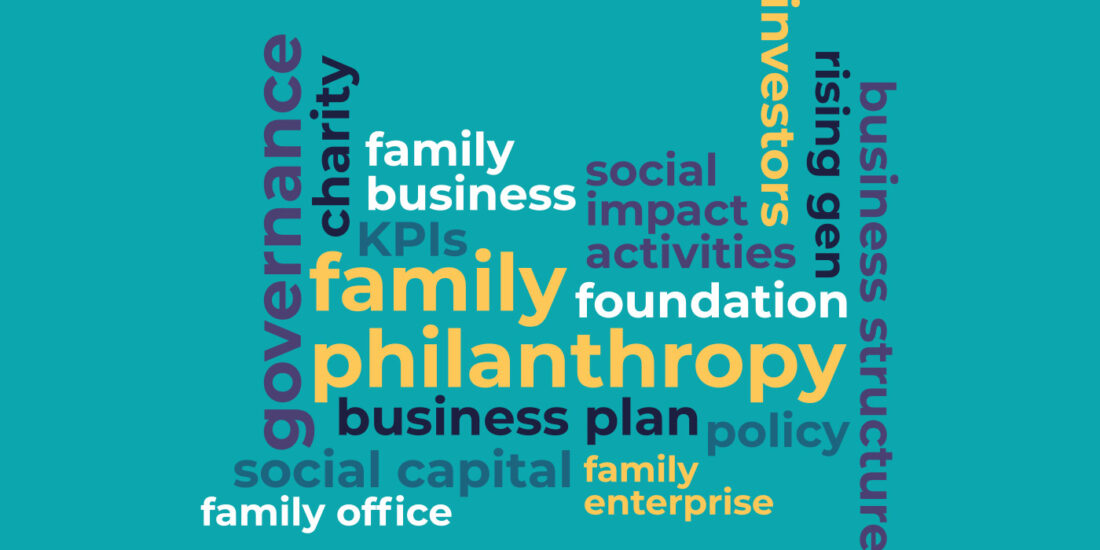Structure and Integration: The Architecture of Succession
This week’s edition of The Practitioner addresses the transitions involved in family enterprise succession and describes how two structural techniques often employed in family enterprise – a private foundation and a family entity (such as limited partnership or limited liability companies) – are good candidates for integrating multiple generations into a family’s succession efforts. Using metaphors from the world of architecture and design, this article, “The Architecture of Succession” by William J. Kambas and N. Todd Angkatavanich of Withersworldwide provides useful insights for professionals from all disciplines.
Advisors are sometimes asked to assist families with building effective, efficient business and/or investment asset holding structures – much like an architect is called on to design a residence. Families must then operate within them – much like living in a home. Ideally, the structure (both in legal form and governance) reflects the personality, goals and intentions of the family, similar to how a home can reflect the lifestyle of the family. Where there is a strong correlation between structure and family values, the family will benefit from an effective means for owning assets and transitioning them to future generations. In some cases, a family office might find itself playing an increasingly important role in building momentum for multigenerational succession.
This article addresses the transitions involved in family enterprise succession and describes how two structural techniques often employed in family enterprise – a private foundation and a family entity (such as limited partnership or limited liability companies) – are good candidates for integrating multiple generations into a family’s succession efforts.
Designing, Operating and Transitioning a Structure
It is fairly common for families (or leadership within a family) to organize one or more asset holding structures and employ them as part of a family enterprise. Family offices are sometimes also employed to help manage these structures. However, regardless of the structure employed, family leadership must prepare successive generations to inherit the assets and independently operate the structure. As observed by Ivan Lansberg in Succeeding Generations “If governance structures are the engine of continuity for family companies, the ongoing education of family members in how to use these structures is the oil without which the engine cannot run.” This is achieved, in large part, through effective communication.
Family members and the family office should communicate the evolution of their roles and responsibilities, which can be facilitated through a family constitution (and/or a family mission statement that memorializes values, goals and intentions), a family assembly (annual or bi-annual meetings where information is shared and voices heard), and/or family counsels and/or committees (smaller groups of appropriate members for specific projects).
The Private Foundation as Technique for Succession
It is common for charitably inclined families to establish a family foundation (often, but not exclusively, a private grant-making foundation), though less formal structures may provide viable alternatives as well.
In addition to serving tax and philanthropic goals, a private foundation is also an effective tool in the architecture of succession. Indeed, there is a certain amount of complexity and legal formality associated with forming and operating a private foundation. That formality provides opportunities for a family to teach children and grandchildren about the family values that produced their wealth in the first place. It also provides a structure for children to meet and develop relationships with family members and the family’s team of advisors.
The goal is not necessarily to raise children who will devote their lives to philanthropy, but rather to teach children about operating within a tax-efficient, legal structure. Specifically, operating within the architecture of a family foundation can serve to integrate and involve multiple generations in: (i) modern portfolio theory, (ii) asset allocation, (iii) taxation, (iv) accounting, (v) budgeting, (vi) state and federal reporting, (vii) the role of a board of directors, (viii) how to choose and evaluate advisors, and (ix) the role of various corporate officers.
This is done because each generation works together to develop roles and responsibilities relating to: (i) how to select a grant recipient, (ii) how to review the use of that grant and hold the recipient accountable, (iii) what other family members value, and (iv) perhaps most importantly, how to select and prioritize their own values. In sum, each generation can be involved with family philanthropy – the more involvement, the better.
Vetting the potential donee charities is a serious undertaking. How long has the charity been in existence and how well organized is it? Who founded it, and who is running it now? Is it financially stable, or barely surviving year to year? What percentage of donations are actually used to implement the charitable mission as opposed to administrative or fundraising expenses? What other organizations do similar work? Do they coordinate their efforts, and if not, why not? If a grant is made, how will those funds be used? Will any reports be generated to show how those funds were used? If you commit to a multi-year grant will the charity be able to organize a multi-year effort to efficiently use those funds? What metrics will be used to measure the success of the charity?
These types of activities and responsibilities can be executed in a team-oriented basis, thereby providing succeeding generations an opportunity to work with senior generations in asset holding structures.
The Family Limited Partnership as Technique for Succession
Family entities, such as partnerships or LLCs are frequently used in connection with the transfer and management of wealth. When correctly implemented and managed, these vehicles can provide an effective mechanism for management of family wealth, tax efficient transfer of family wealth as well as a valuable structure to introduce the younger generation to issues associated with wealth management, corporate governance, compliance, and partnership management and operations. In fact, it is critical for tax and non-tax reasons that appropriate legal formalities are followed and respected. Some of the activities and functions that are necessary include:
- Engaging in negotiations with respect to entity formation and governing provisions, which can provide an opportunity to teach younger generational family members about the importance of management, operations, distributions, and profits and loss provisions, and the consequences associated with them.
- Contribution by family members, both younger and older, of individual assets into the family entity. This may provide an opportunity for younger family members to get their first taste of investing their assets in the relative risks and/or rewards that can be associated with investment.
- Provide an opportunity for younger generation family members to serve as one or more general partners or managers of the entity. This can provide younger family members an opportunity to, either individually or as a collective, engage in the management of an investment entity, including the decision making with respect to selection of investments, liquidation of investments, and other decision making roles. In addition, this could provide an opportunity to have management roles bifurcated into a number of different governing committees, which various family members can be a part of.
- Ensuring compliance and administrative requirements are met. For example, maintaining minutes of entity meetings, resolutions, consents, delivery of annual reports, and tax information. This may provide an opportunity to a younger generation family member to become familiarized various legal and financial documentation, as well as various compliance issues and obligations.
- Holding meetings about business or investments. This provides an opportunity for younger family members to become engaged in discussion and negotiations about the direction of the family entity and play a role in important financial, legal and other decisions of the family entity.
These requirements can enable senior generations (and/or a family office) to transition some or all of the roles and responsibilities down generational lines, at the same time enabling various family members to be involved in different roles.
Integration of succeeding generations into a family entity can be gradual. In fact, gradual integration can provide less experienced family members an opportunity to become involved with the benefit of phased commitment.
Conclusion – Some Stylistic Concerns to Consider
The following is a brief outline of some stylistic considerations helpful in developing a structure for succession – whether using a foundation or family entity. Each requires policies and procedures for the integration of family members, as well as trusted advisors, and communication between and among each of them.
- Introduce generations to the legal structure, roles and responsibilities.
- How will the structure be populated?
- Consider temperament, character, trust and judgment of each family member.
- Integrate family members into the structure
- Give the next gen leaders a role in the structure, even if they don’t join the enterprise as a career.
- Minimize intergenerational competition or managerial conflict by starting them early. Strengths and weaknesses inevitably rise to the surface.
- Employ boards and/or committees for governance of the structure and the decision making process. These roles will likely address employment and remuneration issues.
- Consider family internships whereby junior family members gain qualifications and experience within a specific area (such as the family foundation) and then can segue to the overall enterprise.
- Allow for job shadowing at a family office or within the business. This is less than an internship but will provide valuable insight for career development. This also allows exposure to the day to day demands of a structure and allows junior generations to acclimate into the family asset ownership structure.
- Family mentorship, an informal and ad hoc process, can also provide opportunities for career development and allows for seasoned leaders to groom the junior generation in a less formal setting than a company board, management, or even internship.
About the Contributors
 N. Todd Angkatavanich is a principal at Withers Bergman, LLP. His practice is focused on tax, trusts and estates, and business succession matters for affluent individuals and their families. He regularly advises domestic and international families and family offices with respect to creating trusts and related business structures to preserve, protect and grow family wealth for multiple generations in a tax efficient manner. Todd can be contacted at [email protected].
N. Todd Angkatavanich is a principal at Withers Bergman, LLP. His practice is focused on tax, trusts and estates, and business succession matters for affluent individuals and their families. He regularly advises domestic and international families and family offices with respect to creating trusts and related business structures to preserve, protect and grow family wealth for multiple generations in a tax efficient manner. Todd can be contacted at [email protected].
 William J. Kambas is a senior associate at Withers Bergman LLP. He advises family and entrepreneurial clients worldwide on the development of pragmatic tax planning, governance, and business succession strategies. An integral part of Bill’s practice involves working with families, family enterprises and/or their family offices on the formation, management, and periodic evaluation of multi-national, multi-generational centralized control structures. Bill can be contacted at [email protected].
William J. Kambas is a senior associate at Withers Bergman LLP. He advises family and entrepreneurial clients worldwide on the development of pragmatic tax planning, governance, and business succession strategies. An integral part of Bill’s practice involves working with families, family enterprises and/or their family offices on the formation, management, and periodic evaluation of multi-national, multi-generational centralized control structures. Bill can be contacted at [email protected].
Stay tuned next week for another issue of The Practitioner.
Yours in Practice,
The Practitioner





